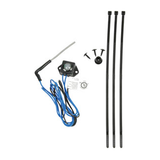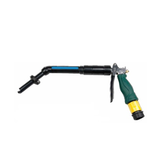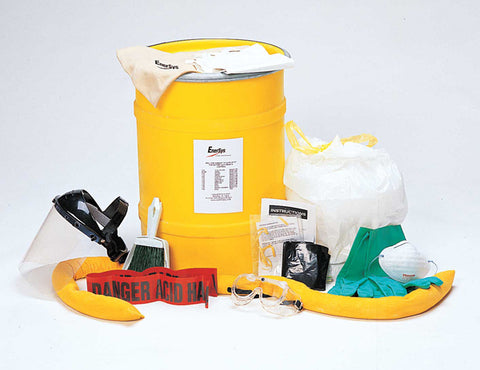If you are looking to effectively cut battery maintenance costs, you should learn more about battery watering kits. Battery watering kits provide a safe, reliable, and time-saving process for filling batteries.
BATTERY ACID
Battery acid, or sulfuric acid, is the main component of a lead-acid battery. Sulfuric acid is an electrolyte or liquid found in lead-acid battery cells. In addition to the sulfuric acid solution, batteries also contain water.
WHY DO WE NEED TO WATER A BATTERY?
A standard industrial, lead-acid battery consists of water to fulfill the sulfuric acid solution. After a battery is charged, it is important to check the water level to ensure that it is at a functional level for the lead-acid battery to continue its normal daily operations. A lead-acid battery’s functionalities are limited or defective when water levels dip too low or are absent altogether. Lead is a metal, any metal that is not maintained in the proper condition will rust, in this case damage the battery. That is why it is important that the water level in the battery is continually maintained.
The power from a lead-acid battery is created by the chemical reaction between the water and acid contained inside the battery. When a lead-acid battery is charged, the water inside the battery is consumed during the chemical reaction through which energy is created. Water also evaporates over time. When the water inside the battery is gone, the battery is dead. A battery watering kit prevents this type of deterioration and failure.
BATTERY WATERING KITS
Battery watering kits come with a single-point watering system that is either fully assembled or that must be assembled after purchase. The kit comes with neatly labeled diagram with instructions for an easy install. The kit consists of a series of tubes with multiple valves connected to them; the number of valves is equal to the number of cells in the battery. The battery watering kit is hassle-free and no tools are needed for assembly. Remove the battery cap, connect the kit, and then connect the water hose. Each cell is then filled up to the proper level. An indicator on the watering valves alerts you when water reaches the correct level. This indicator is designed for a wide visibility and can easily be seen from a distance. When each battery cell is appropriately filled, the water will automatically shut down. Repeat this process whenever the water level in the battery is low.
BATTERY WATERING KIT ACCESSORIES
Following the charging period of a battery, it is important to check the water level in an industrial lead-acid battery. Traditionally, this is done by taking the cap off each cell and making sure the water level is right within the levels of the battery plates (located inside the battery, are visible when you look inside the battery through the vent cap holes). While this is a tedious and time-consuming process, it is necessary to maintain a battery’s working condition. This is where a battery water monitor will save you all the time, money, and labor.
 Battery Water Monitors - - - A Battery water monitor is designed to be your eyes and ears inside the battery. The monitor is equipped with a bright LED visual indicator that alerts operators when it is time to water the battery. The battery water monitor will improve a battery life and eliminate over- and under-watering of batteries. Just like the battery watering kit, the battery water monitor is easy to install can be placed on any battery cell for an accurate read.
Battery Water Monitors - - - A Battery water monitor is designed to be your eyes and ears inside the battery. The monitor is equipped with a bright LED visual indicator that alerts operators when it is time to water the battery. The battery water monitor will improve a battery life and eliminate over- and under-watering of batteries. Just like the battery watering kit, the battery water monitor is easy to install can be placed on any battery cell for an accurate read. Watering Gun - - - The watering gun is helpful for manually filling each cell by hand. It is a safe and efficient method of watering batteries without an automatic watering system. A manual watering gun can be connected to a standard hose or deionizer. Place the tip of the gun into each individual battery cell and squeeze the trigger to continue the process.
Watering Gun - - - The watering gun is helpful for manually filling each cell by hand. It is a safe and efficient method of watering batteries without an automatic watering system. A manual watering gun can be connected to a standard hose or deionizer. Place the tip of the gun into each individual battery cell and squeeze the trigger to continue the process. Gravity Tank - - - A gravity tank is a simple device for filling single-point watering systems. The gravity tank is ideal to assist in applications in which the water will be plumbed into the tank. There is no need to fill the tank manually and the gravity tank can water multiple batteries at one time. Gravity tanks should be positioned a minimum of three feet above the batteries and should be properly secured to ensure proper and efficient water delivery to the battery cells.
Gravity Tank - - - A gravity tank is a simple device for filling single-point watering systems. The gravity tank is ideal to assist in applications in which the water will be plumbed into the tank. There is no need to fill the tank manually and the gravity tank can water multiple batteries at one time. Gravity tanks should be positioned a minimum of three feet above the batteries and should be properly secured to ensure proper and efficient water delivery to the battery cells. Direct Fill Link - - - Direct fill links can be used with a hose (connected to a janitor’s sinks, or spigot somewhere in the warehouse) or a portable water tank. The direct fill link operates like a watering gun equipped with a flow indicator wheel. Also, it is equipped with a pressure-sensitive handle and a connector like a garden hose connection. The direct fill tank does not include a handle lock, which makes it safer to operate because it will immediately shut off if left in a battery, eliminating the possibility of overfilling. The flow indicator encased in the PVC makes it both durable and lightweight. The DF72 model is fast enough to fill a large battery but gentle enough to fill small delicate battery without the risk of overflow.
Direct Fill Link - - - Direct fill links can be used with a hose (connected to a janitor’s sinks, or spigot somewhere in the warehouse) or a portable water tank. The direct fill link operates like a watering gun equipped with a flow indicator wheel. Also, it is equipped with a pressure-sensitive handle and a connector like a garden hose connection. The direct fill tank does not include a handle lock, which makes it safer to operate because it will immediately shut off if left in a battery, eliminating the possibility of overfilling. The flow indicator encased in the PVC makes it both durable and lightweight. The DF72 model is fast enough to fill a large battery but gentle enough to fill small delicate battery without the risk of overflow.
STEP-BY-STEP PROCESS OF INSTALLING A WATERING KIT
- After your battery is charged, remove all the vent caps on the battery cells.
- Using the diagram, snap the battery watering kit into place making sure the valves are snapped in place on each cell.
- Connect a hose to the watering kit.
- Turn the water on.
- Wait until all the indicators on the valves show that each cell has been watered to the proper level. The water will automatically shut down once each cell has been watered to the appropriate level. Once this process is complete, you can remove the watering kit and repeat this process with another battery.
Installing A Fully Assembled Watering Kit: https://www.youtube.com/watch?v=4TDJ-tLaKd4
(If you have a battery water monitor, follow this same process once the monitor indicates that the battery needs watering and you have completed charging the battery.)
For more information on Battery Watering Systems and related items, please visit https://materialshandlingstore.com/
If you need help or advice on the products in our online store or have a question, we would be delighted to serve you. We will respond as fast as possible—within one business day during business hours in the Pacific time zone in the western U.S.
Please contact our warehouse experts at: 844-445-1119

 What is a battery spill kit? It is a package of materials and supplies that are used to clean up and neutralize battery acid spills.
What is a battery spill kit? It is a package of materials and supplies that are used to clean up and neutralize battery acid spills.